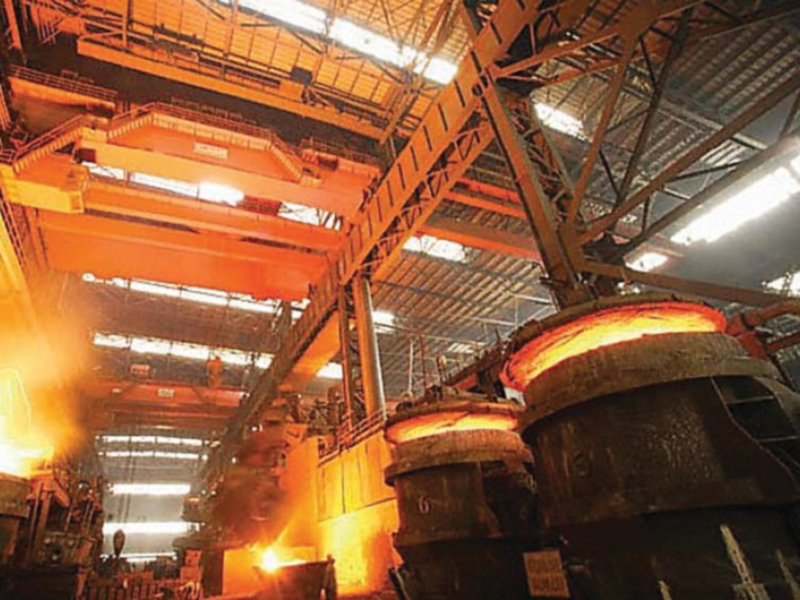
KARACHI:
Pakistan Steel Mills (PSM) has been unable to come out of the red since it lost all its cash reserves in the 2008 global financial crisis. The piece-meal liquidity injection from the government that followed was so small and irregular that production kept on declining. Now it is on the brink.
As a sizeable majority of opinions makers, bureaucrats and businessmen pave way for its eventual privatisation, the employees have asked government to take a logical approach.
A 13-page roadmap, which has been prepared by senior PSM staff, has been circulating among government officials for few days. No one has paid any attention to their proposal or arguments.
The vast majority of employees who have been hired on merit do not even reject the idea of PSM being in private hands in the future. They are, however, sceptical about the way the country’s largest industrial project has been left to crumble.
To increase its capacity utilisation from the current miserable level of 3%, PSM has asked for Rs11.46 billion in cash outlay between March 2014 and June 2015.
From May 2009 to April 2013, the PSM received Rs40.5 in bailout packages. But they were never bailouts in the true sense.
Instead, the government simply helped the mills get commercial loans after every few months, most of which were consumed in paying the past debt of financial institutions and making payments to vendors.
And all along the capacity utilisation of plants kept deceasing - from 64% in the 2008-09 fiscal year, when the crisis set in, to 7% by December 2013, according to the roadmap.
PSM has had a poor financial history. It has remained mostly in losses since it started full-fledged production in the mid-1980s.
From 1969, when work started on the mills under the guidance of then chairman Syed Saeed Jafferi, till 2013, it has seen 26 different managements taking up the reins. Except for three, none of them could exploit the PSM’s dominant position in the market.
All these years until 2000, PSM’s production cost would always be more than revenue despite the fact Pakistan meets most of its steel requirement through imports.
No wonder that it was as far back as May 29, 1997 that the Council of Common Interests gave the go-ahead for privatisation. However, the plan was shelved by the time General (Retd) Pervez Musharraf came to power.
In May 2000, the government restructured the long term debt of Rs19.12 billion, staggering the payment of Rs11.35 billion in annual installments spread over 12 years and agreeing to pay interest costs of Rs7.7 billion from the budget.
That came with a cost. Surplus manpower was laid off and political interference stopped. But that set in motion the longest recovery in PSM’s history. Banks opened up credit lines and on back of a healthier balance sheet it engaged raw material suppliers.
By 2005, all the accumulated losses of Rs9.57 billion were paid off and by June 2008, the company had accumulated profits of Rs9.12 billion and cash reserves of Rs9.3 billion.
As steel prices crashed in the second half of 2008, procedural difficulties and political considerations didn’t allow officials to renegotiate price of raw material supplies, which were locked in at a higher value. The result was Rs26.5 billion loss that year.
Instead of restructuring the financial liabilities, which any company would do in similar circumstances, government resorted to handing out small cash payments as life support.
The roadmap also includes government support over and above the Rs11.46 billion cash injection it has sought. The government would have to bear the liabilities of the National Bank of Pakistan and Sui Southern Gas Company Limited, which stood at Rs57.2 billion on December 31, 2013. But if the recommendations are accepted then PSM will be able to post a profit Rs23 million by June 2015 against the Rs2 billion loss it incurs every month.
It is imperative to remember that PSM has a captive market and it has comfortably made a profit whenever capacity utilisation exceeded the breakeven point of 75%.
Published in The Express Tribune, March 17th, 2014.
Like Business on Facebook, follow @TribuneBiz on Twitter to stay informed and join in the conversation.
COMMENTS (7)
Comments are moderated and generally will be posted if they are on-topic and not abusive.
For more information, please see our Comments FAQ




































































Selling is better than Stealing.
Or if you sold it like 7 years ago (like a certain horrible corrupt undemocratic leader) wanted to it would have been fixed by now.......
Could even have become a real powerhouse....
And its funny how everything is blamed on the global financial crisis rather than the reality .......
Everyone in the management of PSM is looking to make a profit for themselves.
strong text hey Ep "y dnt u write that Asif Zardari PPP destroyeD Pakistan steel mills in hIs tenure and he transffered all the profit of Psm to benazir income Support
Hypocricy at its best
if its fixed there is no need to sell the only steel mill in pakistan, the sole reason why its being sold is that it is not fixed!!!
Sell it all. No time to fix anything. Firesale and get rid.
Pak Steel and PIA will NEVER be privatesed because they are money making machines for corrupt adminstration's past, present and future.